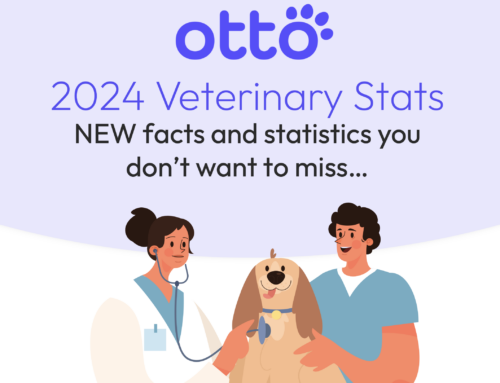
2022 Veterinary Stats
You asked — and it’s our pleasure to deliver! Our 2021 Veterinary Stats blog was so overwhelmingly popular that we scoured the industry for new insights about the state of the veterinary market. We’ve updated statistics from our 2021 blog and added new pearls that every veterinarian should know about the economic state of the industry, pet owner demographics, workforce outlook, and more.

Veterinary industry economic statistics
The economy remains a hot topic as global markets teeter on the brink of recession due to a lasting impact from the pandemic. Here are the key stats you need to know:
There are about 126,138 practicing veterinarians in the US. 75,349 work in private practice.1
Corporate consolidation is a trend we’ve all been watching closely over the past several years. While corporate groups employ approximately 40% of practicing veterinarians, estimates suggest fewer than 40% of all veterinary clinics are corporate owned. Clinics that belong to consolidation groups tend to be larger than the average private practice, which is why corporate clinics employ a disproportionate percentage of the market.
The trend toward consolidation isn’t going anywhere. Brakke Consulting predicts 25% of veterinary practices will be part of a corporate group in 2023 and these clinics will account for 50% of all veterinary visits.2
The pet supplement industry is on track to hit $1 billion by 2027.3
The pet supplement industry is booming, fueled by pet owners seeking natural solutions for wellness. The nutraceutical category is fueling significant growth, but the segment that’s generating the most buzz is CBD.
There is still a lot of gray area surrounding CBD from state to state and country to country, but one thing is for sure: pet owners are interested.
Veterinary care and product sales make up the second-highest spend category at $34.3 billion, an 8.9% increase over 2021.4
According to the American Pet Products Association, the pet industry continues to boom despite economic turmoil. Food and treats made up the highest spending category at $50 billion (a 13.6% increase) followed by spending on veterinary care and products.
The veterinary industry successfully weathered the storm of The Great Recession in 2008 — as compared to other industries that took a major hit — and continues to prove its economic fortitude in the wake of an on-going global pandemic.
Inflation will likely continue to impact price increases in veterinary medicine.5
According to a workforce update from the AVMA, prior to March 2020, the increase in prices for veterinary care year-over-year averaged about 4%. The economy has had a sharp impact on prices, and by December 2022, price increases are projected to be 7% higher.
Many veterinarians are taking a hard look at their services to make sure they’re not missing any charges before instituting rate increases. Those who are raising prices are strategically identifying services where rate increases will have less sticker shock, instead of implementing a standard price increase across all services.
Education and employment statistics
With unprecedented demand for veterinary services, the employment market looks very different for veterinarians in 2022.
Veterinarians hold an average of $183,302 in student loan debt.6
Student loan debt is an ongoing challenge for veterinarians. On average, it costs over $200,000 to attend and graduate from veterinary school. The bright spot in 2022 is that, with increasing demand, salaries and signing bonuses are also increasing and helping offset the weight of these historically crippling student loans.
The median veterinary salary in 2022 is $101,447.7
Last year, we reported the median pay for a veterinarian was $99,250. This year, we’ve seen that salary jump, a trend that should continue as demand intensifies for veterinary care. Veterinary salaries vary widely, ranging from $79,676 up to $128,732. With more demand for specialty care, veterinarians with a specialty focus are seeing huge earning opportunities.
Signing bonuses between $30,000-$50,000 are becoming the norm as staff shortages intensify.8
Yes, the rumors are true. Demand is driving very attractive signing bonuses and generous benefits packages for job-seeking veterinarians. General practitioners typically receive signing bonuses of $30,000-$50,000, while some practitioners occasionally earn signing bonuses up to $100,000. Finder’s fees for specialty practitioners are also emerging as emergency clinicians and specialists become scarce.
10 best-paying states for veterinarians9
- Montana, $150,024
- North Dakota, $149,635
- Vermont, $135,938
- New Jersey, $134,359
- New York, $134,163
- Maine, $132,515
- Utah, $131,888
- Massachusetts, $131,879
- Pennsylvania, $131,008
- Maryland, $130,880
Check out the veterinary salary estimator for new veterinarians.
Okay, so this one isn’t a statistic… but it’s still something every veterinarian should know exists! Check out the AVMA’s salary estimator for new veterinarians to help with employment negotiations and career planning.
Job demand and burnout
Demand and burnout have been some of the hottest topics in veterinary medicine since 2020 (and really even before… ). Check out the essential stats on the state of the workforce:
Nearly 41,000 additional veterinarians will be needed to meet the needs of companion animal healthcare by 2030. Even counting new grads over the next 10 years, a shortage of 15,000 veterinarians will likely occur in 2030.10
Burnout is not a problem of yesterday or today. It’s a problem of the past, present, and future. Large organizations are beginning advocacy efforts to head off the chronic shortage of veterinarians. Practices are investing in technology and workflow improvements today — not only to innovate, but to survive the crush of demand that isn’t going anywhere.
Job outlook for veterinarians from 2020-2030 is expected to grow 17% (much faster than average).11
Last year, we reported that veterinary jobs were expected to grow at a 16% rate, but with booming pet ownership, that growth rate has increased to 17%. This growth rate is much higher than other occupations.
Less experienced veterinarians are working longer hours than experienced veterinarians.12
Data indicates that young veterinarians are working more hours than those in the construction and transport industries, and nearly 10 hours more per week than those in the education and health sectors. Young veterinarians also find themselves in a hectic environment where mentorship is hard to come by. New graduates work approximately 46.6 hours per week, compared to veterinarians with over 30 years of experience who average 33.2 working hours per week.
Major mental health initiates are underway with NOMV and VHMI emerging to support veterinarians, as nearly 70% of veterinarians have lost a colleague or peer to suicide.13
New research shows the wide-felt impact of suicide across the veterinary industry. In the wake of these challenges, organizations such as NOMV have emerged to offer both preventive and consultative mental health services for veterinary professionals.
The attributable cost of burnout of veterinarians to the US industry is between $1- and 2-billion annually in lost revenue.14
Data collected from 5,786 private practice veterinarians indicates burnout has a significant cost. Turnover and reduced working hours are the biggest drivers of lost revenue.
Pet owner demographics and preferences
As pet ownership continues to boom, Millennials emerge as the top pet-owning demographic. Get more essential stats on the state of pet ownership:
75% of Millennials prefer texting over talking.15
Millennials prefer texting because….
- 76% find texts more convenient.
- 63% believe texting is less disruptive than a voice call.
- 19% never check voicemails.
If you’re serving Millennials (and we know you are), texting should be a core component of your communication strategy.
70% of US households own a pet.16
In the US, there are 69 million households that own a dog and 45.3 million households that own a cat. During the pandemic, about 30% of the US adopted at least one pet.
Millennials are the generation most likely to own a pet and account for 32% of all pet owners.17
Millennials often view pets as their starter children (or replacements for children, in some cases). They’re the largest pet-owning demographic, and they treat their pets like family. They hold user experience and efficiency in high regard.
Ownership cost of a dog is $150-$300 per month and an estimated $15,000 over the lifetime of the dog.18
The largest unexpected out-of-pocket cost for pet owners is sudden injury or surgeries. Pet insurance policies cover only 2.7% of pets (3.1 million pets).
Looking forward
As the market continues to evolve to meet the challenges of the moment our industry is experiencing, the team at Otto extends a heartfelt thank you to veterinary professionals for their passion and commitment. Together, we’ll work to innovate to continue to provide care for veterinary teams and the pets they treat.



